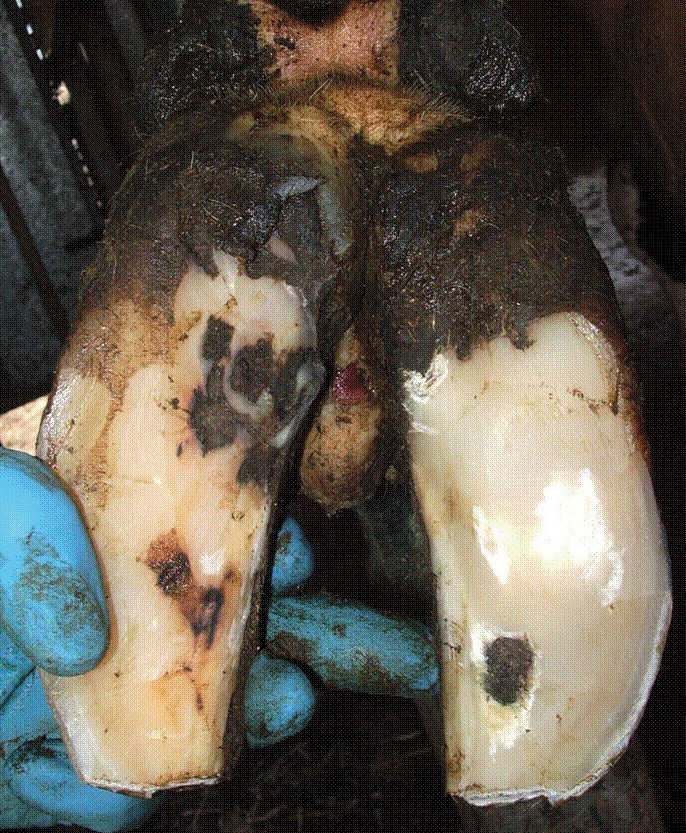- Home
- Knowledge library
- Infectious causes of lameness in the foot
Infectious causes of lameness in the foot
Infections can spread through a herd and cause lameness if not spotted quickly and treated effectively.
Treating infectious claw horn lesions rely on all four success factors, in particular: 1 – low infection pressure.
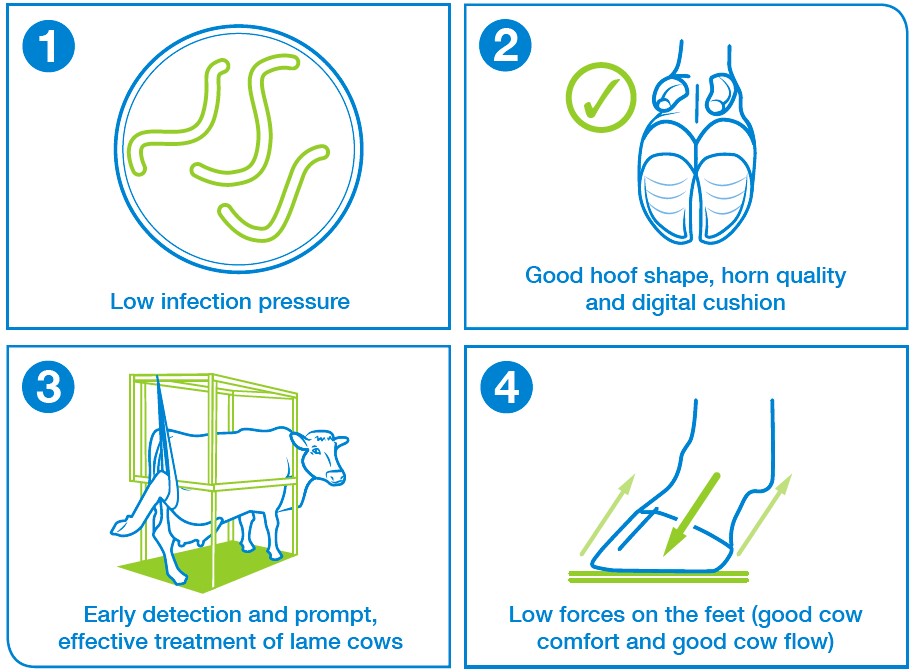
Infectious lesions can be passed between individual animals or from one foot to another in the same cow. It is important to check regularly for these lesions as early detection reduces spread through the herd.
These infections can be spread on contaminated equipment, like hoof knives, so it is important to know how to properly disinfect this equipment.
Remember, your vet will support you to find the best course of action when treating your cows.
Digital dermatitis (DD)
Description
Digital dermatitis is a particularly infectious condition that can spread quickly through the herd. It produces painful lesions on the soft tissues between the claws and the heel, although occasionally it occurs on other soft parts of the foot. Cows often walk very tenderly on the affected feet, sometimes giving the impression that they are walking on 'tip toe' in order to avoid touching the ground with the painful affected area of their hoof.
Key symptoms
- Infection of the skin caused by a type of bacteria
- Raw, painful erosion of skin, most commonly above the heel bulbs
- Can also be found at front of feet or between toes
- Chronic forms have rubbery hairs sprouting from the lesion
Typical risks
- Infected cows in the herd (including chronic carriers)
Associated success factors: 1 and 3 - High proportion of herd affected
Associated success factors: 1 - Poor farm biosecurity (for example, bought-in stock; failure to disinfect between farms)
Associated success factors: 1 and 3 - Poor hygiene (for example, failing to disinfect foot-trimming equipment)
Associated success factors: 1 - Wet feet; constant contact with slurry, which weakens natural skin defences
Associated success factors: 1 and 2 - Poor foot-bathing protocol, including dirty foot-baths
Associated success factors: 1 - Poor slurry management: housing; auto-scrapers with waves of slurry (no slats); overcrowding/not enough space/uneven floors and puddles
Associated success factors: 1 and 2 - Excess time standing (feet do not dry out)
Associated success factors: 4 - Poor immunity (e.g. stress, poor diet or concurrent diseases)
Associated success factors: 1 and 2
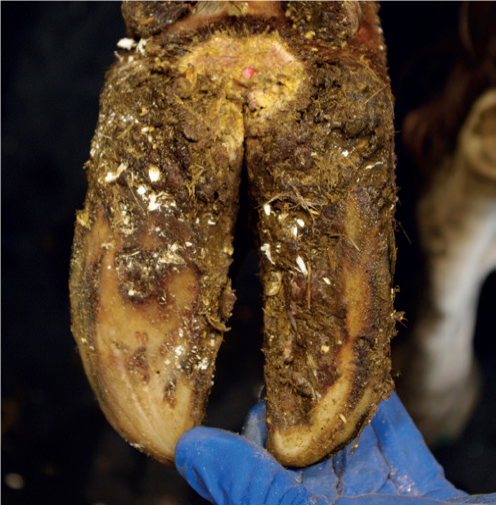
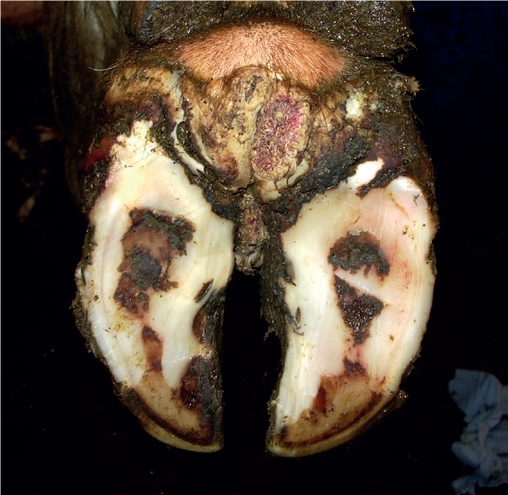
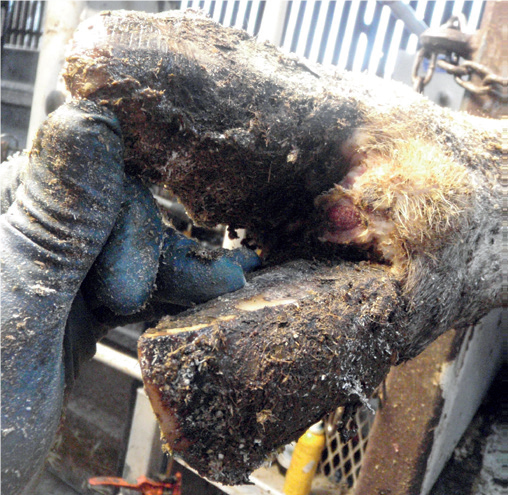
Heel horn erosion (HHE)
Description
Heel horn erosion, or 'slurry heel', is recognised by the damage to the surface of the bulb of the heel. Actual evidence of mobility problems due to the condition may not be present unless it becomes severe. It is often linked to digital dermatitis, in that both conditions are prevalent under poor hygienic conditions in housed dairy herds and tend to be particularly found towards the end of the winter.
In intensively managed dairy herds, the soft horn covering the bulb becomes vulnerable to direct bacterial attack, principally from pathogens existing in slurry and muck, as well as damage from a variety of irritant chemicals also present in slurry. Standing in wet conditions also softens hoof horn, particularly heel horn, and makes this region of the foot even more vulnerable.
Pitted and damaged areas of the sole facilitate the bacterial invasion into the heel area and a massive destruction of the horn of the heel can occur. In some cases, ridges, layers, and deep black and concentric grooves are seen in the heels.
The erosion of heel tissue interferes with the hoof's shock absorption properties, and this may cause pressure to be placed on other parts of the foot; a concurrent lesion may be sole haemorrhage or sole ulcer, possibly due to altered weight bearing in the hoof.
- Caused by enzymes produced by certain bacteria which erode the horn at the heel
- Severe forms can lead to deep pits and grooves
- Useful weight-bearing surface of the foot is lost and the condition can be sore in its own right
Typical risks
- Build-up of causative bacteria – dirty feet; poor foot-bathing
Associated success factors: 1 - Constantly wet feet; poor slurry management
Associated success factors: 1 and 2 - ‘Caking’ of feet: dirty environment and poor foot cleaning
Associated success factors: 1 and 2 - Excess time standing in passageways (instead of lying down)
Associated success factors: 4
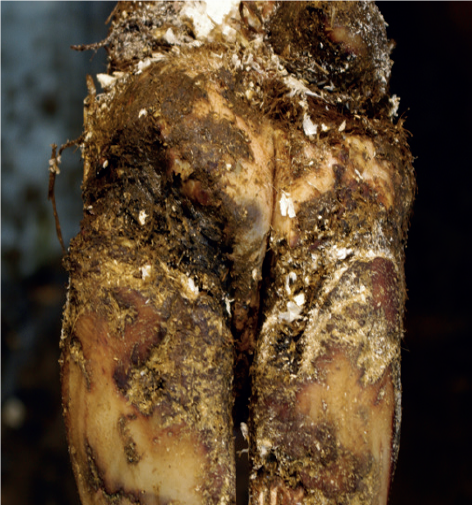
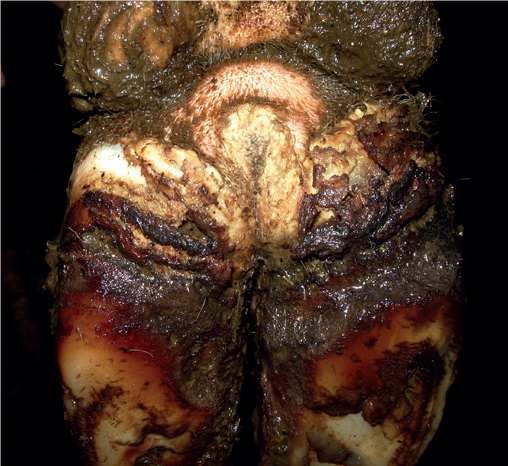
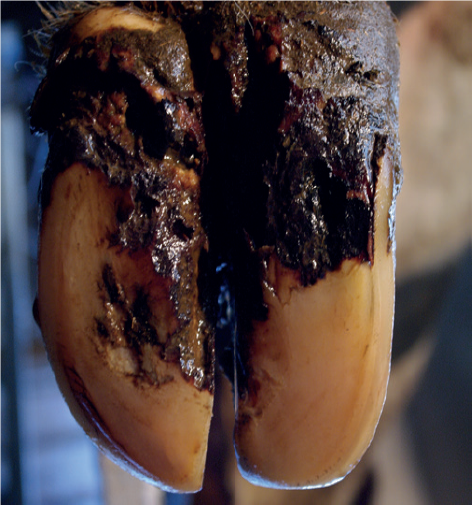
Foul of the foot/Interdigital phlegmon (IP)
Description
Foul-in-the-foot occurs when the skin in between the claws becomes damaged and a bacterium called Fusobacterium necrophorum infects the soft tissue between the digits, although other bacterial species have been linked to the condition. A painful swelling of the foot between the claws and around the adjacent coronary band occurs rapidly and the inflammation may extend to the pastern and fetlock. Other symptoms caused by the illness include pain caused by the pressure of the swelling, severe lameness, fever, and a reduction in milk yield.
More than a single foot is rarely involved at the same time in mature cows but foul can occasionally develop in several feet in calves. As with most foot conditions, the hind limbs are more likely to be affected. The claws are typically markedly separated, with the swelling uniformly distributed between them. As necrosis of the skin progresses, sloughing of tissue and the discharge of pus is likely to follow, and the condition produces a characteristic odour.
Open lesions can be infected with secondary pathogens, complicating treatment and recovery. Severe cases can result in permanent damage to milk yield in the current lactation even if the foot recovers.
- The whole foot is swollen
- Characteristic smell
- Caused by bacteria which enter through broken skin between the claws
- A very aggressive form is called ‘super foul’
Typical risks
- Other infected cows
Associated success factors: 1 - Too slow treating other cows, or they are not treated fully
Associated success factors: 3 - Damage to skin between claws: for example, sharp stones, prickly straw, stony ground around troughs/gateways, coarse sand, hard earth (summer)
Associated success factors: 2 - Poor foot-bathing
Associated success factors: 1 - Warm, wet conditions; muddy gateways or troughs in spring or autumn
Associated success factors: 1
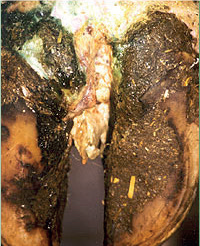
Interdigital hyperplasia/growth (IH)
An interdigital growth, or 'interdigital hyperplasia', is a firm tumour-like mass of tissue that grows in the space between the claws. It is believed to be caused by the continual exposure to slurry, or any chronic irritations or dermatitis in the skin between the claws. There is also a genetic factor behind the development of interdigital hyperplasia. Varying degrees of lameness can be caused by these growths; larger growths tend to be more painful, and may become infected with other diseases such as foul-in-the-foot.
Description
- Protruding flesh (fibrous tissue) between toes
- Caused by any chronic irritation, e.g. by the bacteria responsible for heel erosion or foul
- Can become super-infected with digital dermatitis
Typical risks
- Any irritation between toes, including slow or partial treatment of foul, DD or heel horn erosion; sand irritation
Associated success factors: 3 - Chronic irritation from bacteria which cause heel erosion: dirty feet
Associated success factors: 1 and 2 - Sometimes a breed predisposition (hereditary/genetics)
Associated success factors: 2 - Poor hoof conformation; long toes and splayed feet
Associated success factors: 2 - Inadequate/delayed treatment of foul of the foot
Associated success factors: 3
